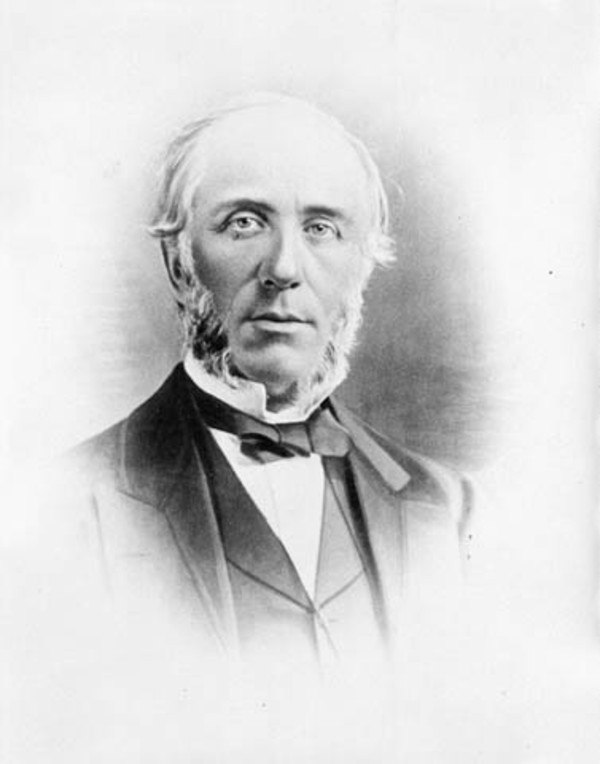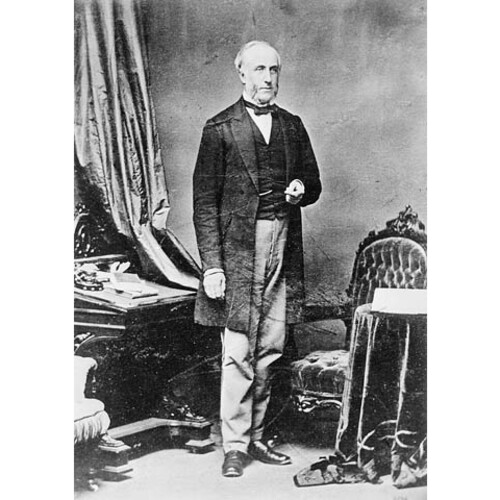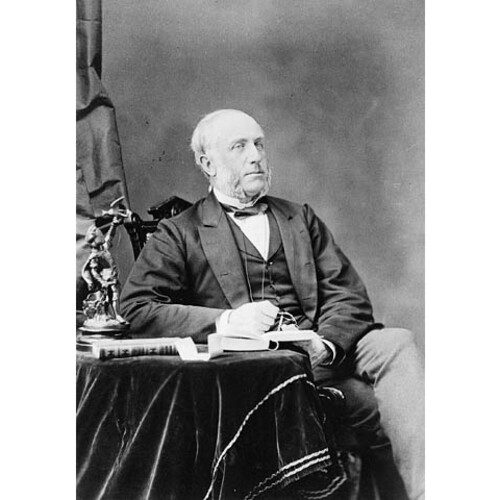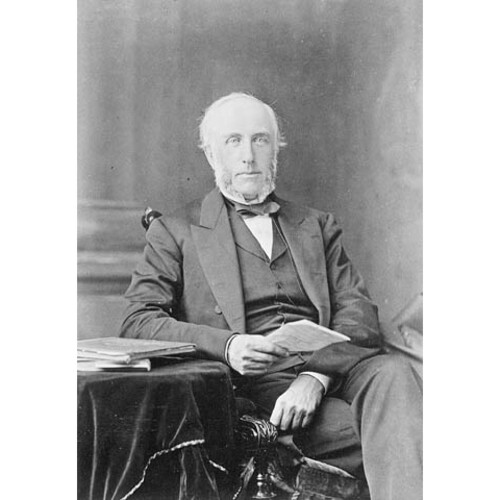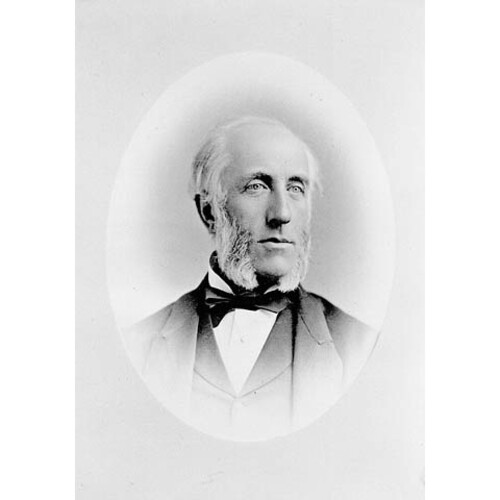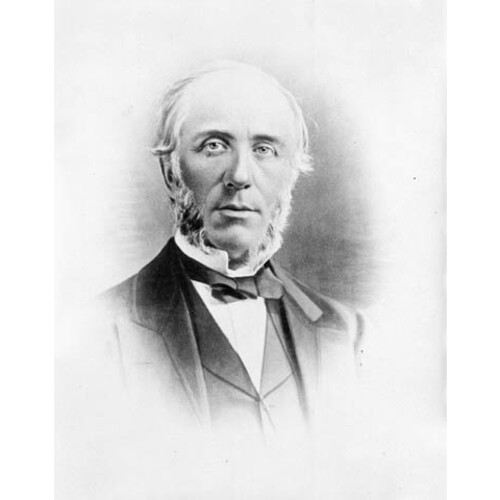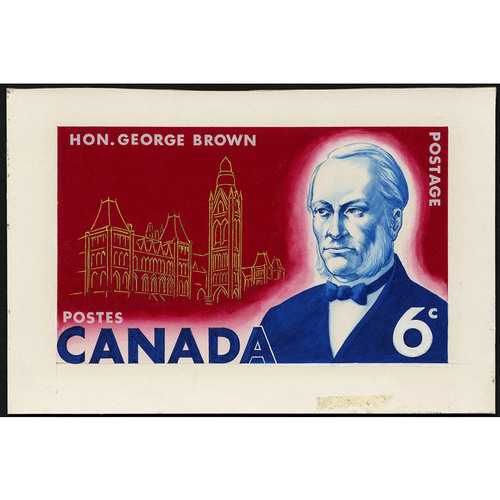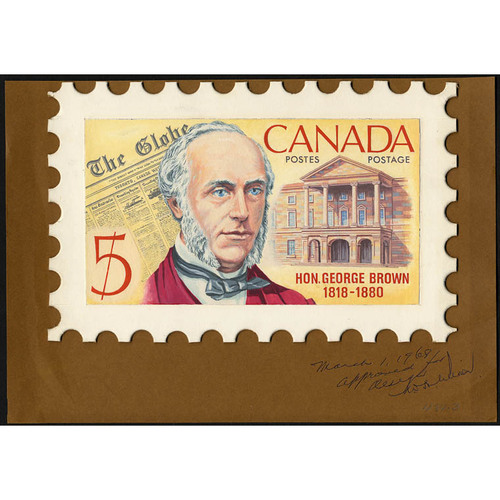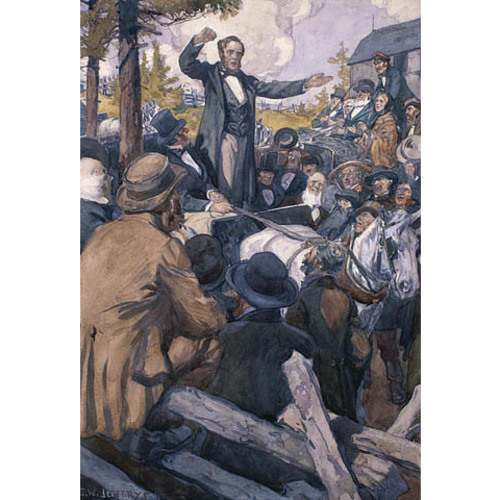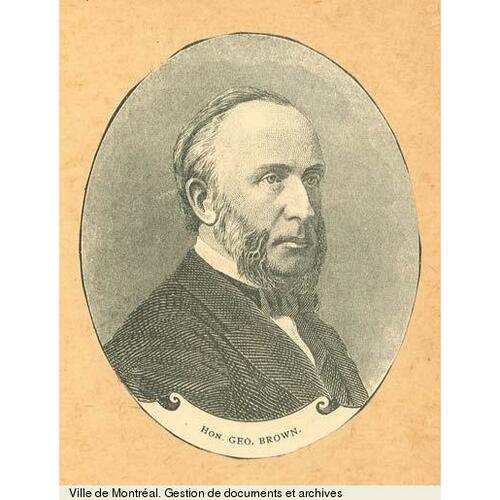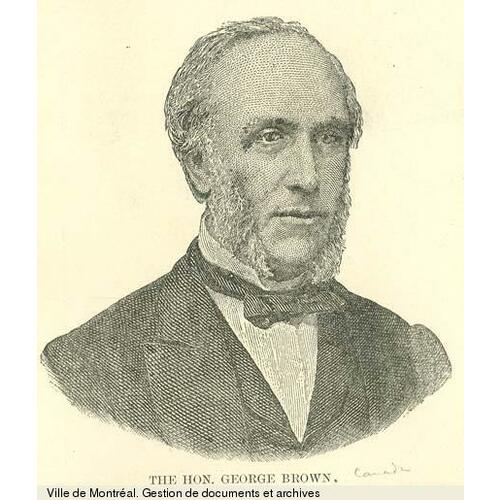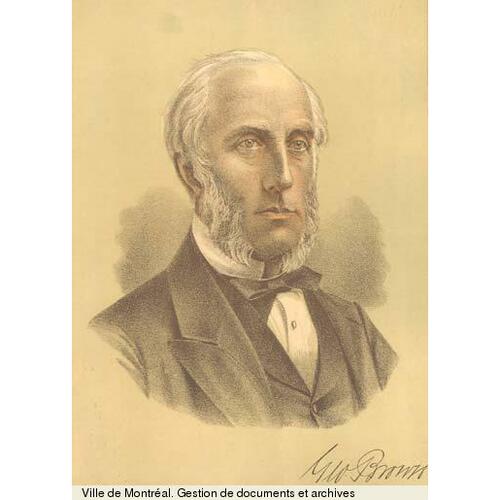BROWN, GEORGE, journalist and politician; b. at Alloa, Clackmannan, Scotland, 29 Nov. 1818; d. at Toronto, Ont., 9 May 1880.
George Brown was the elder son in the family of six children of Peter Brown* and Marianne, daughter of George Mackenzie, gentleman, of Stornoway on the Isle of Lewis. Peter ran a prosperous wholesale business in Edinburgh, but he also spent periods at Alloa up the Firth of Forth helping to direct a local glassworks. Thus George Brown’s life began in the placid little Forthside port though the family returned to Edinburgh before he was eight. He attended Edinburgh’s celebrated High School and its Southern Academy, and he was always proud to link himself with Scotland’s national capital. After leaving school with prizes and honours, he joined his father’s business, and began to settle into a life in well-to-do Edinburgh commercial society.
George was very close to his father. Peter Brown was a convinced Whig-Liberal and evangelical Presbyterian, an ardent believer in civil and religious liberty, progress, the economic liberalism of Adam Smith, and the destruction of Tory aristocratic privilege. Moreover, he set a strong political example by actively sharing in the struggle for borough reform in Edinburgh and the larger campaign that won the parliamentary reform bill of 1832. In 1836, however, Peter was involved, as collector of assessments in Edinburgh, in a loss of nearly £2,800 of municipal funds, which had somehow mixed with his private accounts. There was no charge against him and his guarantors made good the loss, but he strove urgently to redeem the money and his name. With the onset of the depression of 1837 he saw nothing else to do but try a new start in America. And so, on 30 April 1837, George Brown, aged 18, set out from Liverpool with his father for New York.
Within weeks of landing there in June, they had opened a small dry goods shop, in which George was the only assistant. It thrived sufficiently that they could send for the family the next year. The business apparently continued to do moderately well, but Peter Brown was turning to other interests. In the next few years he became a contributor to the New York Albion, the weekly paper of the British emigrant community. Once more his son would acquire from him both a fervent abolitionism and a rooted preference for the British parliamentary system over the American republican model. Yet more than that, Peter Brown published his views in a book early in 1842, The fame and glory of England vindicated . . . (New York and London), and the ready reception of this work, at least by British emigrants in the United States and in neighbouring English Canada, stirred its author to turn fully to journalism.Again assisted by his willing son, he began the British Chronicle in New York on 30 June 1842, a little weekly more political and less literary in content than the Albion.
The new paper soon started noting Canadian affairs, as circulation spread in that quarter. It commented on the course of the union that had been set up in 1841 between the former provinces of Upper and Lower Canada, and approved the plan of responsible government which was backed by the existing Liberal or Reform leaders there, Robert Baldwin*, Francis Hincks*, and Louis-Hippolyte La Fontaine*. George Brown, moreover, began to travel up to Canada in the service of his father’s paper. His role was growing, as he finished his apprenticeship in journalism. In March 1843, when he was still only 24, he was denominated in the Chronicle as “Publisher,” his father as “Editor.” That spring he spent some time in Canadian centres such as Toronto, Kingston, and Montreal, talking with politicians and editors and acquiring considerable knowledge of the prospects of the country.
Meanwhile, Peter Brown had thoroughly committed the British Chronicle on an issue that had recently come to a head in Scotland. There the evangelical element in the established Church of Scotland had decided to withdraw from the state Presbyterian church altogether, in the cause of religious freedom as they saw it. Thus occurred the “Great Disruption” of May 1843, and the birth of the Free Church of Scotland. Inevitably Peter Brown’s sympathies were with the new Free Kirk. Indeed, there was considerable support for the movement throughout Scottish communities in America. Moreover, it grew evident that the conflict within Presbyterianism could also erupt in Canada because of colonial Scottish feelings for one or the other party in the homeland.
In this circumstance, Free Kirk sympathizers in Canada looked to the British Chronicle, which spoke so warmly for their side. In the summer of 1843 a group of leading Free Church supporters in the Toronto area signed an invitation and put up a bond to persuade Peter Brown to move his paper to Canada. This invitation they passed through the Reverend William Rintoul* to George Brown on his travels through Toronto. He was already interested in a move himself, partly because of friendly contacts he had made with leading Canadian Reformers, partly because he felt that British Canada would be far more congenial than the American republic and that in its youth and sparse development it offered much better possibilities for getting ahead than crowded New York. He put these arguments forcefully to his father and won his consent. On 22 July the British Chronicle made a last appearance, announcing that its editor would henceforth publish a weekly paper in Toronto named the Banner, expressing a Presbyterian interest and upholding “Reform principles” on all great public issues.
On 18 August the first issue of the Browns’ Toronto Banner came out. The editorial columns – which dominated the little four-page papers of the day – were divided between the “Religious Department” and the “Secular Department,” the provinces of Peter and George Brown respectively. The first department at once took up the Free Church cause; the second was slower to commit itself. But before the end of 1843, the resignation of the chief Liberal ministers, Baldwin, La Fontaine, and Hincks, from the government of Sir Charles Metcalfe* provided a major public issue on which George Brown soon began to speak out in the name of Reform principles.
It appeared to him that Governor Metcalfe’s insistence on controlling the power of patronage himself, the question on which his Liberal ministers had resigned, was a repudiation of the principle of responsible government. Metcalfe’s dismissal of the Reform-dominated assembly that December fully decided him. He made the Banner the forceful champion of the Reform leaders as the political crisis continued.
But that paper, with its own sectarian cause to pursue, could only be a part-time champion at best. And George Brown’s own interests were becoming wholly centred in politics. Recognizing his journalistic powers, moreover, a group of prominent Toronto Reformers approached him to found a new party paper; four of them offered to provide £250 starting capital. The sum meant more then – but also indicates how relatively simple it was to equip a small colonial weekly newspaper. Though they would continue the Banner, the Browns decided to establish the Toronto Globe. It first appeared on 5 March 1844, and it was really George Brown’s from the start. He above all was to make it the most powerful newspaper in British America.
He did so through his strong and stirring editorials, by pushing always for the latest and most detailed news reports (so that the Globe would be read, reluctantly, even by political enemies), and by seeking constantly to increase circulation through providing ever better press facilities. He introduced the new Hoe rotary press to Upper Canada before his paper was even three months old, and the greater production this permitted enabled the Globe to set up a book and job printing office also. In 1845 he established the Western Globe, to serve Reformers in the rising southwestern regions of the province, with its own sub-office in London to which material from the Toronto edition was regularly conveyed by road. The Toronto Globe itself advanced from weekly to semi-weekly; by 1849 it had tri-weekly issues, reflecting its expanding circulation, and a weekly edition specifically intended for the countryside was added. It was a further sign of the success of Brown’s “forward policy” that the Globe in October 1853 became a daily, printed by a steam press. By that time Brown’s paper had already become a province-wide institution, and soon could claim – with few to deny it – the largest circulation in all British North America.
As the Globe’s external influence expanded, it naturally grew internally as well. It had begun in the 1840s with a staff composed of George and Peter Brown, a printer, and a boy apprentice or two: one of them, according to tradition, George’s young brother, Gordon. In the 1850s the paper acquired a whole staff of printers (with union aims expressed in strikes in 1853 and 1854), pressroom and engine hands, reporters, and parliamentary correspondents; and the day had passed when George Brown would write the bulk of the editorials himself. He still kept a tight control over business affairs and the main lines of editorial policy, so that the popular presumption that he and the Globe were synonymous was not entirely wrong. But regular editorial management passed to his brother Gordon, named sub-editor in 1850 at the age of 22 – Peter Brown having then retired at 66, after closing down the Banner in 1848.
In short, within a few years of establishing his newspaper, George Brown had moved it from the day of personal journalism to the era of big newspaper business in Canada. He made himself a leading Toronto businessman in the process and also shaped a formidable political power. But though he was to enter politics himself, his strongest concern would always remain with the Globe, just as it did at its beginning, in March 1844.
He gave his first significant political speech in that very month on 25 March, to the Reform Association of Canada, at a meeting held in Toronto to protest Sir Charles Metcalfe’s attempt to carry on government with but a trio of ministers, W. H. Draper, Dominick Daly*, and Denis-Benjamin Viger*, who had not yet managed to fill up the other ministerial offices. The young Globe editor’s ringing denunciation of such an un-British and illiberal practice roused warm response. From that time onward, his fervent, powerful oratory was often called upon at party gatherings and public meetings. Meanwhile, he vigorously engaged the Globe in the Reformers’ battle against Metcalfe and the Tory–Conservative forces that were rallying to the governor general’s side. There was, indeed, a growing reaction in English-speaking Canada against what seemed excessively partisan Reform insistence on removing the governor’s power over patronage. Hence, in the elections held that autumn, pro-Metcalfe forces carried Canada West (popularly still called Upper Canada), though the victory of La Fontaine’s Liberals in Canada East, the largely French-speaking Lower Canadian section, meant that the new Conservative ministry had only a bare majority over all.
Many Canadian electors had apparently not fully understood the requirements of responsible government exercised through party rule. In the next few years of Tory–Conservative administration George Brown worked diligently to enlighten the public, and thus to strengthen the Reform party under Baldwin and Hincks in Upper Canada. By 1847, when the weak Tory–Conservative ministry failed to improve its position through a reconstruction, the chance for a resurgence of Reform seemed at hand: especially when Britain now accepted the full principle of responsible rule for Canada and sent a new governor general, Lord Elgin [Bruce*], instructed to put that principle decisively into effect.
In the elections of 1847–48 the Globe trumpeted the Liberal cause once more. But further, its editor personally entered into the contest in the western county of Oxford, where Baldwin asked him to conduct a campaign for Hincks who was away in Britain. This was Brown’s first full-fledged election campaign, even though he was not a candidate himself. Undoubtedly his enthusiasm and untiring efforts in speaking across the riding did a good deal to win the seat for Hincks – though it also left a heritage of jealousy between two strong-minded men. The Reformers swept into power in both sections of Canada, and in March 1848 the La Fontaine–Baldwin government took office as a wholly Reform cabinet embodying the principle of responsible rule.
This new administration, developing a broad programme of reforms, had a task for the editor of the chief party journal in the west. He was named secretary of a commission of inquiry to investigate alleged abuses in the provincial penitentiary at Kingston. The commission began hearings there in June and proceeded through the rest of 1848 as Brown worked zealously in a role which his energy and ability made markedly influential. This exhaustive inquiry produced voluminous evidence of brutality and maladministration, and the existing warden, Henry Smith*, was removed from office. The commission’s report, which Brown drafted as secretary early in 1849, passed withering judgement on “most frightful oppression – revolting inhumanity.” It also projected major forward steps in Canadian penology; for example, in recommending the separation of hardened criminals, first offenders, and juveniles, in making provisions for rehabilitation and aftercare, and in urging the appointment of permanent, salaried prison inspectors.
Otherwise, in 1849, Brown’s role was still essentially that of Globe editor. But his paper was now the official organ for the government in Upper Canada and he stood high in party circles. Accordingly, he was closely identified that spring with the La Fontaine–Baldwin ministry in supporting their contentious rebellion losses bill against angry Tory protests, which included an attack on his own home in Toronto. Later in that year of depression and turmoil he worked still more ardently to combat the movement for annexation to the United States that focussed on the Montreal Annexation Manifesto of October, but had lesser repercussions in Upper Canada as well. Through the Globe Brown strongly backed Baldwin’s efforts to dissociate the Upper Canadian Reform party from annexationism, particularly in a by-election in December 1849 when the Reform candidate, Peter Perry*, an old radical, displayed unfortunate annexationist leanings.
Despite pressure from the party leadership and the party organ, however, Perry was elected without having fully disavowed annexation, at least as a future possibility. Yet his victory was more indicative of local left-wing Reform discontent with central party direction than of any real support for annexationism, now fast disappearing. In fact, Perry’s success spurred radical elements, soon termed “Clear Grits” in the Globe, to shape a new movement by early 1850, which sought to push the party onward to “advanced” reforms in the belief that the leaders and their more moderate supporters had grown altogether too content with office. They demanded cheap and simple government close to the people and, above all, a fully democratic constitution on the American elective model. George Brown’s own commitment to the Baldwin ministry and his distrust of American written constitutions and egalitarian democracy made him a determined foe of Clear Grit radical proposals. His journal urged the superiority of British responsible cabinet government, so recently won for Canada. But the Clear Grits held local conventions, adopted a thoroughgoing democratic platform, and established a new organ of their own in Toronto, the North American, edited by William McDougall*, a clever young radical lawyer.
Furthermore, the Grits took up another reform cause with wide popular appeal in Upper Canada: the secularization of the clergy reserves set up by imperial statute at the founding of the province in 1791 to support a Protestant clergy. The Anglicans still received the major share of the funds from the sale of reserve lands, but this situation was sharply questioned, both by those who sought a more equitable division and by those who wanted the reserves abolished altogether as an improper endowment of churches by the state.
George Brown himself naturally agreed with the latter stand. For him the state should know no church, and churches should be voluntarily sustained by their adherents. On this “voluntary principle” he was in accord with the Clear Grits and various evangelical Protestant bodies as well as his own Free Kirk supporters. But he rejected the Clear Grits politically for their constitutional views, and relied on the declared intentions of the Baldwin government to settle the reserves – deeming the radicals’ demand a mere attempt to make political capital for themselves. The parliamentary session of 1850 gave him doubts, however. Resolutions were passed asking for an imperial act to authorize the Canadian legislature to deal with the reserves themselves. Yet James Price*, the minister who moved them, did so only as a private member, and La Fontaine and the French Canadian Reformers he led were plainly reluctant to tamper with a religious endowment. As Roman Catholics accepting ties of church and state, they approved of state support for religion – the antithesis of Brown’s own position.
Another measure of the session further aroused his concern about Catholic influence on government policy. This, the Upper Canada school act introduced by Hincks, enlarged provisions for separate denominational schools in the western system of public education, so that Catholic schools, specifically, could more readily be organized to receive state support. Brown saw this enlargement as an alarming inroad into the maintenance of one non-sectarian public system. His Globe called it “the entering wedge.” Then, as he and other voluntaryists were becoming increasingly exercised over “state church” influences on public affairs, the papal aggression question burst in England in the fall of 1850.
The root of the issue was a papal brief recreating a Roman Catholic hierarchy in England for the first time since the Reformation. The brief was at least unwise in declaring this realm of Anglicanism, Puritanism, and Methodism to be now returned to an “orbit” around Rome. There was strong response from Protestants, already reacting to the resurgent ultramontane and anti-liberal zeal of the papacy under Pius IX. Brown’s Globe was only one of numerous liberal or voluntaryist-minded journals in Canada that commented severely on these papal and Catholic presumptions, but its power and vehemence involved it in a bitter exchange of doctrinal arguments and name-calling with the local Catholic press. Inevitably, by the spring of 1851, Brown had emerged as either a potent voluntaryist champion or an arch anti-Catholic in a country deeply divided by religious passions.
Meanwhile he had decided to try for parliament himself, to strengthen the cause there of non-sectarian public education and the separation of church and state. He stood in a by-election for Haldimand County in April 1851. His chief opponent was William Lyon Mackenzie*, now back, amnestied, from his long American exile and a rather obstreperous ally of the Grit radicals. The power of Mackenzie’s name among western Grit farmers, the half-hearted support which the Reform leaders gave their own somewhat troublesome candidate, Brown, and, in particular, a powerful Catholic appeal to Irish Reformers to reject the sworn enemy of their faith, all combined to give the victory to Mackenzie. Brown’s growing breach with the ministry widened and his concern over Catholic influence in politics was only reinforced.
Then in parliament that June Baldwin resigned from office when Clear Grit objections to his reconstruction of the Court of Chancery produced a temporary Upper Canadian majority against him. His chief lieutenant, Francis Hincks, became the western head of the government – a man to whom Brown had never been as loyal as he had been to Baldwin, and whose motives he distrusted as more concerned with keeping office to promote the new era of railways than with upholding true liberal and voluntaryist principles. Early in July, the Globe editor brought his paper out against the ministry, on a path of independent Reform: the “one course for the opponents of priestcraft and state churchism.” His judgement that a Hincks government would prove an unprincipled office-holding combination seemed to be borne out when it speedily came to terms with the Grits. McDougall’s North American now became a government paper, and two Clear Grits, Malcolm Cameron and John Rolph*, entered the cabinet. The Grits still hoped to impel the ministry on to radical reform, but Brown was right in predicting that they would be swamped in the combination by the more conservative-minded forces of the railway builders following Hincks and the French Canadians now led by Augustin Morin* as successor to La Fontaine.
The new Hincks–Morin Liberal government successfully appealed to the country in the autumn of 1851. Brown ran as an independent Reformer in the southwestern county of Kent. This time he was elected easily, thanks to the strength of voluntaryism there and effective work by prominent local Reformers, one of whom, Alexander Mackenzie*, was to become his closest supporter. The elections were over by early January 1852, but parliament did not meet till August. The provincial offices first had to be transferred from Toronto to Quebec; it was a sign of the sectional division in the Canadian union that the seat of government had to shift between the former capitals of Upper and Lower Canada, no one permanent seat having yet been found.
Sectionalism had been embedded in the very constitution of the union, since the two Canadas had been given equal representation in its parliament. Underlying this political division, however, was the deeper division between two cultural communities: that of Upper Canada, English-speaking and mainly Protestant; that of Lower Canada, largely French-speaking and Roman Catholic. The distinction could only be sharpened by the different aims of zealous western voluntaryism, striving to end state support and recognition of religion, and equally zealous French Canadian Catholicism, seeking to establish new religious corporations for educational and welfare purposes or to back demands from the Upper Canadian Catholic minority for further separate school rights. Sectional strains mounted when the reserves question and ecclesiastical corporations bills came up, and when a new separate school measure for the west was carried through by Lower Canadian votes. It was charged that a “French domination” was imposing its will on Upper Canada. George Brown was in the forefront of debate, clearly representing a broader constituency in the west than just his own riding of Kent.
As parliament went on into 1853, he made himself still more prominent in Upper Canada by moving a resolution in March for representation by population. This would give the western section a preponderance of parliamentary seats for its population had now outstripped the east’s. French Canadians naturally feared being swamped by a western, English ascendancy, and held to the bulwark of equal sectional representation. In any case, Brown’s motion did not win many adherents as yet in English Canada, which was more divided politically between Reform and Tory parties than the more compact, ethnically united French Canadian minority. The idea of “rep by pop,” not originally Brown’s, would become strongly associated with him, and would increasingly gain western support as sectional strife continued in the union.
Indeed by 1854 it threatened to break up the Reform party and topple the Hincks–Morin government. In June the failure of that government to settle the reserves – though they now had imperial authorization to act – was a major factor in creating a sudden combination of dissentient groups that defeated Hincks in parliament and led to elections that summer. Brown was handily returned for Lambton, a constituency newly divided off from Kent. Out of the party turmoil he hoped to shape a new alignment to advance voluntaryism and secularize the reserves, composed of non-radical Reformers and moderate Conservatives, many of whom were now ready to support secularization.
The governing coalition that emerged when parliament met in September dashed Brown’s hopes. It combined Hincks’ former following of moderate Liberals and the French Canadian group still under Morin with the Tory–Conservative forces led by Sir Allan MacNab*. In this new MacNab–Morin regime, Tories and Conservatives would accept the need to abolish the reserves; and they and the followers of Hincks could foster railway development in the alliance, which upheld the French Canadians’ cultural interests. In short, this Liberal–Conservative coalition represented a fresh attempt to bridge sectional divisions, leaving in opposition George Brown and some western voluntaryists, the Clear Grit radical wing, and the smaller, largely French Canadian eastern radical faction, termed the Rouges, under Antoine-Aimé Dorion*.
Among these fragments of Reform there was no recognized opposition leader, but Brown increasingly took a prominent role, thanks to his parliamentary prowess and the strength of the Globe. When the government’s promised measure to abolish the reserves came up in October 1854, he and his former Clear Grit foes could vote together in criticizing loopholes in the bill, though they accepted its main tenor. Brown could also at least cooperate with the Lower Canadian Rouges in attacking alleged governmental waste and corruption in railway schemes, especially in regard to the costly Grand Trunk then building the main line across the province. In fact, he also might reach common ground with Rouges on many “state church” issues, since they had inherited the French Canadian strain of anti-clericalism. Nevertheless, any Liberal opposition front could only be a loose working alliance of sectional elements at best, and Brown’s prime effort was to form a coherent Reform party within the western half of the union.
He achieved a good deal of progress during 1855. The Globe made overtures to the Clear Grits, urging the need for Reform unity. Leading Grit radicals were ready to sink their differences with Brown and put by their hopes of sweeping elective constitutional reforms in the more urgent need to fight revived Conservative power and the dangers of “French Catholic domination.” It was an important sign, therefore, when Brown bought out the Grit North American in February and its editor, McDougall, joined the Globe staff. Then in May a new bill for Upper Canadian separate schools brought still more important developments. The act of 1855 introduced by Étienne Taché* was suddenly put through parliament in its last days at Quebec, when many Upper Canadian members had left for home. It was passed, moreover, by an eastern majority over the votes of those westerners still on hand, including Brown. This event seemed hard proof of Lower Canadian domination of the union, and of the Liberal–Conservative ministry’s connivance in that domination.
In the indignation that swept Upper Canada many Grit adherents called for dissolution of the union. But Brown, the Toronto businessman, was perhaps more conscious of the commercial values of the Canadian union than embattled western farmers. He and the Globe argued for representation by population instead: to remake rather than destroy the union, assure justice for Upper Canada but maintain the unity of the St Lawrence transport system and the broad economic development that would be lost by separation. They waged a campaign for rep by pop through Upper Canada in the summer of 1855. By autumn Grittism had been largely won to it, and Brown had supplied a powerful policy on which to focus the reunification of Upper Canadian Reform.
He made further gains the next year. In parliament in the spring of 1856, the Liberal–Conservative regime, facing sectional discords and internal divisions itself, lost some of its Liberal supporters to the Reform forces in opposition. The ministry was reconstructed in May, when MacNab was replaced by the far more able John A. Macdonald* as western leader – and still only narrowly avoided defeat in the assembly. During heated debates earlier in the session Brown and Macdonald had had a sharply significant personal encounter. Macdonald, who had always supported the cause of an old family friend, Henry Smith, the ex-warden of the Kingston penitentiary, was carried away in anger to accuse Brown as secretary of the 1848–49 commission of having falsified evidence and suborned witnesses. The committee of inquiry, which the latter immediately requested, heard a mass of testimony that palpably exonerated Brown; but it produced only a non-committal verdict, being politically weighted against him. A proud and sensitive man, he was left with the grave charges unretracted, which put more than political barriers between him and his great Conservative rival.
In August 1856, Brown began a new campaign through the Globe, calling for the annexation to Canada of the vast British territories beyond the Great Lakes, still the preserve of the fur-trading Hudson’s Bay Company. He had long been interested in the potentialities of the North-West. Now they were attracting widespread attention in Upper Canada, both from land-hungry farmers seeking new frontiers to settle and from Toronto businessmen hoping to direct new flows of trade to their fast rising metropolis. Brown and his brother Gordon were closely identified themselves with Toronto efforts to open communications with the North-West. And northwestern expansion was another powerful policy for a resurgent Upper Canadian Reform party, on which commercial and agrarian interests could unite. The time seemed ripe to cement party unity, when in December 1856 the emerging Toronto business and professional leadership group (with George Brown at its core) issued a call for a Reform convention to gather in the city.
The convention held on 8 Jan. 1857 brought together 150 Brownites, Clear Grits, and Liberals who had formerly followed Hincks. It readily adopted a platform that marked successful Reform reunion and included representation by population, annexation of the North-West, national non-sectarian education, and free trade. It was Brown’s platform; he dominated the proceedings and his friends the central party structure. He had remade the party in a Brownite image. Its opponents still might dub it “Clear Grit” – and “Grits” the Brownite Liberals would long be termed. But the old Clear Grit radicalism of American elective democracy had really been submerged within Victorian British parliamentary Liberalism.
The reorganized party faced its test when elections were announced in November by the government, now led by Macdonald and his powerful French Canadian ally, George-Étienne Cartier. Brownite Reform forces won a clear majority in Upper Canada, and Brown himself was triumphantly returned for both Toronto and North Oxford, but in Lower Canada the Rouges under Dorion were decisively defeated by Cartier’s large Bleu Conservative contingent. Hence the Macdonald–Cartier regime was able to continue in office when the new parliament opened at Toronto in February 1858. But Brown pressed hard on the ministry’s weakness in Upper Canada; by midsummer it was in trouble, meeting dissension in its ranks and minor defeats in the house. Accordingly, the Macdonald–Cartier cabinet decided to resign when a vote of 28 July rejected the choice of Ottawa as future permanent capital, a choice with which the cabinet was identified.
The governor general, Sir Edmund Head*, called on Brown as the leading figure in the opposition to form a new government. The danger for Brown was obvious, since his side had no real majority in the house. Yet if he refused, he would virtually endorse the constant Conservative charge that he was a “governmental impossibility.” He worked closely with Dorion, and succeeded in constructing an able cabinet, dedicated to establishing representation by population, but with constitutional guarantees for French Canada. As might be expected, this Brown–Dorion ministry was nevertheless defeated when it met parliament on 2 August; but Brown had then hoped to go to the country and win a new general election. Head refused his request, on the ground that elections had been held so recently. Brown could only resign, as he did on 4 August.
His “Short Administration” would become a standard item of political comic relief thereafter. Still, one can scarcely see that he had a better course. Furthermore, his Conservative foes revealed their own insecurity on resuming office in the narrowly divided house. They were sworn into one set of posts, then promptly switched them for another, which let them take advantage of a legal technicality and avoid having to withdraw from parliament to undergo by-elections, as the Brown–Dorion ministers had had to do. This “Double Shuffle” both added salt to Brown’s wounds and reinforced his belief that, under the existing sectionally divided union, government had become hopelessly unprincipled and venal. The failure of the courts to condemn the double shuffle in December 1858 [see Draper] further increased his bitterness, and a bad-tempered parliamentary session at Quebec in the spring of 1859 left him in a deeply despondent mood. The fact was that, for all his abundant physical energy, he was exhausted after two years of unrelenting political effort. In this state he let the Globe play with radical notions of dissolution of the union and written, American-style-constitutions – chiefly through the agency of an able Globe editorial writer, George Sheppard, with strong American constitutional preferences of his own.
During the summer of 1859, Brown largely recovered his spirits and his hold over his journal. In fact, he launched the Globe on a new campaign, for a federal union to settle the ills of the two parts of divided Canada, so that each could govern its own sectional interests, under one general government based on representation by population for matters of common concern. In September he laid plans for a new Upper Canada Reform convention to reinvigorate his disheartened party. Plainly, he meant to bring it to adopt federation: a constitutional remedy which could appeal to both sections of Canada, if rep by pop alone could not, and one – as he made clear – which would be a step toward “a great confederation” of all British America and the incorporation of the North-West as well. He and his Toronto leadership group worked carefully to arrange the key convention committees to ensure that any dissolutionist radical opinions would be outweighed at the grand party gathering.
The convention of 570 delegates met in St Lawrence Hall, Toronto, on 9 Nov. 1859. Again Brown’s presence, and engineering, dominated its affairs. Sheppard spoke powerfully for “simple dissolution,” reflecting a widespread agrarian Grit suspicion of political complexity. Then William McDougall offered a usefully vague compromise term, “some joint authority,” for the federal power to link two sectional governments; Brown made an eloquent appeal to national aspirations in urging federal union. Federation effectively gained the day. Thereafter the Globe boomed it exultantly across the west as chosen party policy.
Brown intended to move the convention programme early in the legislative session of 1860. But soon dissent appeared within his own parliamentary ranks, arising from moderate elements this time. Notably exemplified in John Sandfield Macdonald, they held that it was still possible to gain power in the existing union by winning more support in Lower Canada from ministerialists who were tired of extravagant, Grand Trunk–influenced government, and that a proposal for sweeping constitutional change would simply frighten them away. Brown, however, argued that an attempt at still another coalition merely for office would settle nothing. He won his point, but only by threatening to resign as party leader. When he finally did bring forward the convention policy, it was about 30 April and late in the session, and backing for it was visibly uncertain. It was easily defeated. Nevertheless Brown had recorded a party stand on federalism of much future consequence.
Meanwhile his health was suffering. He had evidently not fully recovered from his earlier strains – and these were financial as well as political, going back to the depression that had begun in 1857. By that date Brown had become an entrepreneur with sizeable investments in Upper Canada, quite apart from maintaining his large newspaper business. In the early 1850s he had acquired extensive lands in Lambton County, and when the new Great Western Railway was built across them in 1855 the village of Bothwell had risen on his estate. The “Laird of Bothwell” sold farm and town lots, built roads and mills, cut lumber, and operated a cabinet factory. But this was in boom time, in a country that virtually ran on credit. When the depression of 1857 brought swift contraction, Brown was soon in difficulties, with Bothwell mortgaged, and funds again committed to Globe improvements in advance of circulation and advertising revenues.
He struggled through several bad years, surviving without a serious loss of property. But the struggles – and his creditors – were particularly demanding in 1860. As a result, his health collapsed completely in the winter of 1861, and he was sent to bed for more than two months. He thus missed the parliamentary session of 1861, and was still weak in June when a general election was called. Brown did his best; but he was beaten in his Toronto seat and was out of parliament for the first time in ten years. At any rate, business conditions were at last improving because of rising American demands for lumber and other Canadian products, stemming from the onset of the Civil War that year. But more than that, oil fields were being developed in the vicinity of Bothwell; by the fall of 1861 it stood to become a boom town. Brown held on to his own estate and bought more land. His financial prospects now looked excellent. Meanwhile his Globe was warmly supporting the northern cause in the Civil War – Brown’s strong abolitionism made him a firm opponent of the slave-owning South – and no less warmly attacking the Grand Trunk railway influence and eastern power behind the Cartier–Macdonald regime in Canada.
In 1862, with his health still uncertain, he decided to take a long recuperative holiday in Great Britain. He landed in Liverpool on 23 July, his first return in 25 years. After a month in London, he moved on to Edinburgh, and there saw such old friends as William and Thomas Nelson, of the Nelson publishing family, who had been his school mates at the High School. Above all, he met their sister, Anne Nelson, lively, intelligent, and cultivated. He fell deeply in love at 43, and on 27 November, he and Anne were married at Abden House, the Nelson home.
They returned to Canada in late December, to receive a tumultuous mass welcome in Toronto. But soon, despite George Brown’s whole-hearted affection for his new domestic life, he felt the pull of unfinished political business. With his health fully restored and his horizons undoubtedly broadened by viewing colonial sectional politics from the centre of empire, he decided on another try: a man no less vigorous and resolute than before, but somehow more detached and judicious – perhaps the mellowing result of marriage.
Brown easily won a by-election in South Oxford in March 1863. He found himself in a parliament both altered and much the same. A moderate Liberal government under Sandfield Macdonald had replaced a crumbling Conservative regime in 1862, but Sandfield’s ministry was just one more attempt to keep the existing union running without dealing with underlying sectional and constitutional problems. Sandfield, in fact, had pinned his faith to the double majority principle, whereby neither section of the union would be governed against the will of its own parliamentary majority. But that principle had foundered shortly before Brown rejoined parliament at Quebec in April, when another separate school bill had been passed for Upper Canada without having received western majority support. The discredited government was thereupon recast to give it a firmer Reform character, Brown playing a prominent part as he reasserted his old influence in his party even though he preferred to stay outside the ministry. Dorion and his Rouge friends replaced moderate eastern Liberals in the cabinet; associates of Brown, such as Oliver Mowat*, entered its western half. This new Macdonald–Dorion ministry then went to the polls in July 1863. The Reformers won in Upper Canada emphatically (as Brown again did in South Oxford), but Cartier’s Conservatives equally swept the east. The two sides were practically in balance. Deadlock was approaching.
The fruitless power struggles in parliament that autumn showed that no real change had been made in the political situation. Brown, however, acting as a private member, disclosed a significantly new approach. He announced his intention to move for a select committee to inquire impartially into the sectional problems of Canada and report on the best means of remedying them. It was a constructive proposal, carefully worded to be non-partisan. But his motion did not come to a vote until the spring session of 1864, as the house battled on through more bitter, barren factional contests. The Sandfield Macdonald ministry, unable to govern, gave up in March. The Conservative cabinet that replaced it, under John A. Macdonald and Sir Étienne Taché, had no greater chance of achievement, or even survival. Brown’s single-minded aim was to settle the constitutional impasse and retire from the burden of parliament to the warm family world he longed for – his first child, Margaret, had been born that January. Finally, on 19 May 1864, his motion passed. He became chairman of a select committee drawn from leading members of all parties; he put it industriously to work. And on 14 June it reported to parliament “a strong feeling” in favour of “a federative system.”
This was only a general statement in a brief progress report. Yet it supplied the essential basis for a way out when, on the very day of that report, the Macdonald–Taché government collapsed. Brown moved decisively to use this latest crisis: he let the Conservative leaders know that he would support theirs or any other ministry if they would act to solve the constitutional problem. They were ready to respond. On 17 June, John A. Macdonald and Alexander Tilloch Galt*, a leading proponent of British North American federation, met with Brown in his room at the St Louis Hotel. Cartier later joined the discussions. It was soon decided that the only solution lay “in the federative principle suggested by the report of Mr. Brown’s committee,” and that an approach should first be made to the Atlantic provinces to seek a general British American federal union. Brown had looked ultimately toward this larger goal, but he had deemed earlier Conservative advocacy of it to be premature and mainly used as a red herring to evade action on Canada’s own internal constitutional problem. But since the Conservatives had now agreed to federate the Canadian union, he could only see a great gain if the other colonies could also be included. He agreed, though reluctantly, to enter the government with two Reform supporters. The new coalition to seek a confederation would thus have overwhelming strength in the house, backed both by the Brownite Grit western majority and Cartier’s Bleu eastern majority. Deadlock was over. George Brown had initiated the breakthrough, and the movement to a whole new union.
On 22 June 1864 the “Great Coalition” was announced to a wildly jubilant house. Brown joined Macdonald and Cartier and their colleagues in the cabinet as president of the council, along with Mowat and McDougall as his Reform associates; all under Taché as prime minister. During the summer this strong new government developed the outlines of a federal scheme to lay before representatives of the Maritime provinces at a meeting in Charlottetown in September. Among the eight Canadian cabinet members who went to the Charlottetown conference, Brown took an important role, on 5 September presenting to it the constitutional structure proposed for federal union. After the conference unanimously endorsed confederation in principle, he went on to meetings at Halifax and Saint John.
In October came the larger Quebec conference to work out detailed terms for confederation. Again Brown took a leading part in this critically important gathering – being, after all, the strongest representative there of the most powerful provincial interest, that of the future Ontario. Yet his own interest was not just sectional, but national. For example, it was he who moved the essential resolution stipulating central and provincial governments for the union, with provision for the admission of the North-West, British Columbia, and Vancouver Island. He took a stand against an elected senate in the new federal parliament, as he had previously against the elective upper house introduced in the province of Canada, because of the problem of basing British responsible government on the confidence of two representative bodies, particularly if they were of different party complexion. And he wanted simple, non-political new provincial authorities, since they were to be left only “insignificant” matters to deal with. Brown believed that the establishing of representation by population in the central government (another resolution which he moved) would give Upper Canada its due voice in important national matters, and that the provincial regimes would take the divisive, but essentially local, sectional issues out of high politics. It was a clouded vision, but at least a well-meaning one for this “sectional” politician become a confederation statesman.
After the conference closed, Brown was one of the spokesmen who first presented the actual plan for confederation embodied in the 72 Quebec resolutions to the Canadian people, in his case, through a major speech in Toronto on 3 November. Later that month he set out for England. He had been chosen to open discussions with the imperial government on the project of union, and also to discuss the transfer of the North-West from the HBC to this grand new design. During December he went into these questions with British government and opposition leaders in London, as well as the question of British North American defence, made urgent by strained relations with the United States arising out of the Civil War, now hastening towards a northern victory. He returned early in 1865, sure of imperial approval for the confederation project, hopeful of progress on the transfer of the North-West, but worried by apparent British readiness to see the still weak colonies “shift for themselves” in the face of American danger.
The Canadian parliament met again in February, to debate the Quebec conference scheme and to give the approval to be expected from the government’s big majority. Still, the confederation debates of 1865 were no mere rubber stamp; they expressed doubts and penetrating criticism, national hopes and powerful arguments for union. In the latter regard, Brown’s own speech of 8 February was perhaps his greatest, and one of the strongest in support of confederation. Before the vote was taken, however, the plan had met reverses in the Maritimes, where the pro-confederation government of Samuel Leonard Tilley* had lost an election in New Brunswick in March, and the Charles Tupper* regime had not even dared to introduce the Quebec scheme in the Nova Scotian assembly.
Another Canadian mission was accordingly sent to England to discuss the future of confederation, this time composed of Brown, Macdonald, Cartier, and Galt. After busy meetings and much social life in London in May and June, they succeeded handsomely, gaining imperial assurance of cooperation in forwarding the project and of the defence of Canada in event of war, though now that the Civil War had ended any American military threat seemed fast receding. The British government also promised aid in negotiating a new trade agreement with the United States, since the existing reciprocity treaty was to end the following year. While in Britain, Brown was fully involved in the working out of these vital concerns of the confederation movement. The remaining essential was winning back the Maritimes. After the mission returned he played a part here also.
In September 1865 he and Galt represented Canada at the Confederate Trade Council in Quebec, a smaller meeting of the provinces to consider their commercial future now that their reciprocity agreement with the United States was to be terminated. The common approach to trade the council sought, and the Maritime contacts Brown made, stood him in good stead afterwards when the Canadian government sent him to the Maritimes to try the climate anew on confederation. He marked a hopeful trend in New Brunswick, and dealt with Tilley andLieutenant Governor Arthur Hamilton Gordon* on ways to advance it. On his return in mid-November, however, he found the Canadian government had decided on a policy of their own for seeking reciprocity with the United States, by joint legislative action rather than by treaty, and this he firmly opposed.
Brown had long upheld reciprocity, as an economic liberal seeking to remove, not raise, the barriers of tariffs, and as an Upper Canadian who had seen his own section benefit from it. But he did believe its price might come too high. Legislative reciprocity, virtually open to change at the will of an American congressional lobby, would, he thought, place Canadian prosperity at the mercy of American dictation. He fought the proposal through tense cabinet discussions, yet failed to convince his colleagues. At length, on 19 December, he resigned. There is no doubt that the issue was crucial to Brown, though it is also true, of course, that strains had long been rising in the cabinet between two strong chieftains and old opponents, Macdonald and himself. Moreover Brown was still uneasy in a coalition, however great its purpose, and felt he was unduly committed in an old game of power-building and office-dealing. Hence he was emotionally ready to resign over an issue as important as reciprocity. There was meaning in the telegram he sent his wife: “I am a free man once more.”
In any case, confederation now was well in train. Brown continued wholeheartedly to support it, in the Globe and at the next session of parliament in 1866. He had the satisfaction of seeing New Brunswick elect Tilley’s pro-confederates in the spring, and Nova Scotia reopen the quest for union – not to mention, meanwhile, the failure of the legislative reciprocity approach to a scarcely interested United States. Towards the close of the year the final confederation conference met in London to draft the imperial bill, still fundamentally embodying the Quebec resolutions Brown had helped to formulate. It was passed as the British North America Act in March 1867.
By this time Brown was deep in party politics again, renewing contact with former Rouge friends such as Dorion and Luther Holton, who had opposed the confederation ministry, and striving to strengthen Reform party lines in Upper Canada, eroded by the years of coalition. Brown felt that any need for coalition would end with the inception of confederation and that party politics should reassert themselves in the new federal Canadian state. On the other hand, Macdonald Conservatives and some Liberals held that the new era should be instituted by a broad, non-partisan administration. Pressed by friends to take the lead for Reform again, challenged by the coalitionist stand, Brown overcame his sincere desire to be done with parliamentary life, and, as before, made one more try.
There was another large, excited Reform convention in Toronto in June 1867 to reaffirm party unity. There Brown virtually read from the party William McDougall and William Howland*, the two leading Liberals who still sat firmly in the coalition cabinet, Mowat having long since withdrawn to a judicial post. But the elections for the new union legislatures, held later in the summer, soon proved that the Reform convention had by no means overcome the wide popular appeal of the “patriotic” no-party cry. In August, Brown was beaten himself in South Ontario, a far from safe seat. By September it was clear that sufficient Reformers had joined with the Conservatives to give a majority in Ontario to the new federal regime of Sir John A. Macdonald and to a similar coalition government for the province led by Sandfield Macdonald. Brown himself was offered safer seats; but his feelings against parliamentary life had only been confirmed. In October 1867 he left Canada for an extended family holiday in Scotland: out of politics before he had turned 49.
In the next few years he gave himself largely to his growing family, now including two more children, Catherine Edith and George Mackenzie, to the Globe, his first love, and to his considerable business interests. He had sold his Bothwell properties to an oil syndicate in 1865 for $275,000, making him decidedly wealthy. But in 1866 he had bought a brand new estate at Bow Park near Brantford, where he began to develop a large herd of prime shorthorn cattle. Bow Park grew from a family country home to a cattle breeding enterprise that took much of his time. Nevertheless, he did not seek to escape from politics, only from public life. His journal was as potent a Reform organ as ever. Its owner, and former party leader, was regularly consulted by the Grit inner circle, whether in the provincial capital, Toronto, or the federal at Ottawa. Furthermore, he had a particularly close connection with Alexander Mackenzie, leader of the federal Liberal opposition in all but name, who had once been his election agent in early days in Kent and Lambton and later his trusted lieutenant in the old Canadian assembly.
Through the Globe he worked to bring about the end of Sandfield Macdonald’s “Patent Combination” in Ontario. In the spring of 1871 the second Ontario election gave the Reformers the balance of power in the provincial house, possibly helped by the fact that Brown in his paper had made peace with Roman Catholic voters, declaring that divisive sectarian issues had now been “banished.” Sandfield held on in office till December, but then a Liberal government under Edward Blake* replaced him. The next year, when Blake decided to move to the federal sphere, Brown helped persuade an old friend, Oliver Mowat, to leave the judicial bench and head the ministry, thus opening the long Mowat era in Ontario government in October 1872.
Meanwhile Brown had had his troubles as Globe proprietor, having faced a major printing strike by the Toronto typographical union from March to June of 1872. The strike ended in mutual concessions, but not before Brown and other “master printers” had had 18 printers arrested for intimidation, though they were released on bail and never brought to trial. The next year there was the very different excitement of the “Pacific Scandal.” Here the Globe was on the side of the angels, as it denounced the corrupt payment of election funds to the chief Conservative ministers by Sir Hugh Allan*, who had been granted the Canadian Pacific Railway charter. The Macdonald federal government fell; the Liberals under Mackenzie won a sweeping election victory early in 1874. The Mackenzie government then asked Brown to undertake a mission to the United States to seek a new reciprocity treaty.
He readily accepted the task of negotiating for the kind of reciprocity he supported. Moreover there seemed to be some hope that the Americans would now agree to a treaty, in order to avoid having to pay a cash settlement for access to the Canadian Atlantic fisheries. Brown arrived in Washington in February, officially to serve as joint commissioner with the British minister in Washington, Sir Edward Thornton, but really to carry the weight of the work himself. For several months he fenced and bargained with the American secretary of state, the affable but wily Hamilton Fish. An extensive treaty gradually was drafted, providing for reciprocal free admission of many manufactures as well as natural products. On 18 June the draft treaty was finally sent to Congress for approval. Fish had so delayed, however, that there was not time for it to be considered before the adjournment four days later. The Senate simply set it aside; there was little chance it would be revived since any American interest by now had waned. In fact, for Brown’s draft treaty of 1874 one well may use the dictum, the operation was successful but the patient died.
He played a declining part in political affairs after his Washington mission though he never entirely left them. He had been appointed a senator in 1874 but did not take his seat in Ottawa until the next year. Indeed, his attendance at the Senate was generally sporadic, and not a major return to politics. Still, Brown maintained his link with Mackenzie and the very core of stout Victorian Grittism. In this respect, he supported Mackenzie in 1874–75 against the passing discontents of the able Edward Blake, and the young Canada First idealists who temporarily gathered to him, finding Mackenzie’s rule too stale and uninspired. Blake was to be won back, but Brown and the Globe also joined battle with the redoubtable Goldwin Smith*, the sharp-tongued intellectual publicist who for a time was allied with the short-lived Canada First group. Indeed, there began a long feud with Smith, largely because of his presumption that Canada was doomed to partisan excesses and colonial inferiority until it breathed the pure air of independence, which to him seemed to mean annexation to the United States.
From 1875, however, Brown was spending his time increasingly on affairs at his Bow Park estate. There his neighbour’s son, Alexander Graham Bell*, offered him and his brother Gordon a share in the rights to the “sound telegraphy” system Bell had invented if they would advance $600 and patent the device in England. Both agreed to advance the money, and George Brown undertook to apply for a British patent for Bell in a forthcoming visit to Britain. But when the senator arrived in London in February 1876, the technical advice he received there discouraged him as to the value of Bell’s invention. He did not proceed, the agreement lapsed, and Brown did not become part-owner of a future Bell empire. He was more concerned with his plan to launch a joint-stock company in Britain to build Bow Park into a major pedigreed cattle-raising venture. Already well known to leading British stockbreeders and aristocratic fanciers alike, he succeeded in raising close to $400,000 of capital, and returned to Canada in May to obtain his charter.
Under these new auspices Bow Park grew much larger, and it became a show-place for agriculturalists visiting Canada. Yet by 1877 the country was deep in a world depression, and the market for pedigreed stock was not growing as anticipated. Brown’s enterprise was already heading into difficulties when the next year he turned his attention back to politics, to support the Liberal cause in the federal election of September 1878. He spoke through southern Ontario against the Conservative call for a “National Policy” of tariff protection. But after the National Policy, and the depression, swept Macdonald back into office, Brown returned to the mounting financial troubles of Bow Park.
In 1879 the British stockholders of his company sent over an expert manager, John Clay, to try to save the situation. By early December Clay’s work of reorganizing was beginning to bring an improvement, when a fire destroyed most of the estate’s main buildings. Then on Christmas day another blaze, almost certainly of incendiary origin, burned out the stables. George Brown’s pioneering venture into pedigreed stock raising in Canada seemed ruined. Moreover, early in 1880 he was facing problems at the Globe, where he had again invested heavily in improvements to produce a new multi-page machine-folded edition; delays in installation had held back its appearance.
On 25 March 1880, at the Globe, a former worker in the engine room, George Bennett, discharged by his foreman for intemperance, came into Brown’s office to seek a certificate that he had served five years. Brown tried to send the man, whom he did not know, to see the foreman. There was an argument; Bennett, who had been drinking, suddenly pointed a gun. As Brown grasped for it, it fired, inflicting a flesh wound in his thigh. His assailant was quickly secured. Brown’s injury was pronounced slight, and he left thankfully for Lambton Lodge, his Toronto home. But while he stayed at home, calling meetings there on Globe business and worrying incessantly over the losses at Bow Park, the wound, far from healing, grew inflamed. During April his financial outlook brightened, as a good cattle sale was made in Chicago and the new Globe edition came out. But by this time his leg was badly infected and he had too greatly taxed his strength. Gradually he gave way to fever and delirium, then coma. Early on 9 May he died at Lambton Lodge, at the age of 61.
His life was saddened at the end by a sense of failure. Yet actually Bow Park recovered under new direction, and the Globe assuredly continued to flourish. Above all, there remained Brown’s achievements in journalism, the Liberal party, and Canadian confederation itself. Lord Monck*, governor general in the confederation years, termed him “the man whose conduct in 1864 had rendered the project of union feasible.” A man, also, who refused the lieutenant governorship of Ontario in 1875 and a knighthood in 1879, he preferred always to remain George Brown of the Globe – which was distinction enough in itself.
[This piece is essentially derived from my biography, Brown of The Globe. Little new research material on Brown has turned up since the writing of this biography. The main primary source was, and is, the Brown papers in the PAC. Some secondary works of value have certainly appeared since Brown of The Globe was written. They offer useful related and background information, though they do not deal centrally with Brown or alter my interpretation of him in any significant way. A selection of such works is given below, along with some older volumes. But with respect to the latter, Brown of The Globe, of course, utilized many more, and again provides the fullest references to them. j.m.s.c.]
Alexander Mackenzie, The life and speeches of Hon. George Brown (Toronto, 1882). Careless, Union of the Canadas. Charles Clarke, Sixty years in Upper Canada, with autobiographical recollections (Toronto, 1908). Creighton, Macdonald, young politician; Macdonald, old chieftain; Road to confederation. Dent, Last forty years. John Lewis, George Brown (Toronto, 1906). Morton, Critical years. Waite, Life and times of confederation. James Young, Public men and public life in Canada, being recollections of parliament and the press, and embracing a succinct account of the stirring events which led to the confederation of British North America into the Dominion of Canada (Toronto, 1902).
Cite This Article
J. M. S. Careless, “BROWN, GEORGE,” in Dictionary of Canadian Biography, vol. 10, University of Toronto/Université Laval, 2003–, accessed January 1, 2026, https://www.biographi.ca/en/bio/brown_george_10E.html.
The citation above shows the format for footnotes and endnotes according to the Chicago manual of style (16th edition). Information to be used in other citation formats:
| Permalink: | https://www.biographi.ca/en/bio/brown_george_10E.html |
| Author of Article: | J. M. S. Careless |
| Title of Article: | BROWN, GEORGE |
| Publication Name: | Dictionary of Canadian Biography, vol. 10 |
| Publisher: | University of Toronto/Université Laval |
| Year of publication: | 1972 |
| Year of revision: | 1972 |
| Access Date: | January 1, 2026 |


